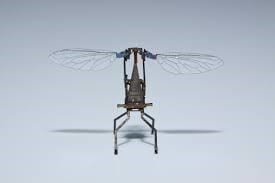What do you think would happen if bees were to suddenly disappear from our planet? You might then have to give up some of your favorite foods for bees are responsible for pollinating about three-quarters of global crop species, including strawberries, apples, almonds and grapes. Unfortunately, land clearing, climate change and the use of pesticides are already impacting the bee population and causing problems for farmers.
Docker, L. (Photographer). (2011). Pollination of a bee [digital image]. Retrieved from https://www.flickr.com/photos/aussiegall/6105263663
Researchers have come along at the Wyss Institute for Biologically Inspired Engineering at Harvard University to create robotic bees. A RoboBee is only half the size of a paperclip and weighs less than one-tenth of a gram. These bee-size robots have the ability to lift off the ground and hover midair when attached to a power supply. These RoboBees have been designed to perform myriad roles in agriculture or disaster relief.
Courtesy: National Science Foundation
Walmart has already taken steps to manufacture and use their own robotic bees, known as “pollination drones,” to pollinate crops autonomously. These robotic bees use sensors and cameras to help them navigate among the crops and potentially will be able to pollinate as effectively as real bees.
NASA is also getting in on the act. As part of a project known as Marsbees, NASA is planning to use tiny robotic bees to explore the surface of Mars because they will be able to obtain and relay information faster and more easily than the Mars rover can. The robotic bees will be able to cover more land space at a fraction of the cost, and will now use the Mars rovers as charging stations.
The potential decrease or even elimination of the bee population in our ecosystem almost certainly would have had devastating consequences. We have the researchers and roboticists in the field and their incredible ingenuity to thank for the robotic version coming to our rescue!

